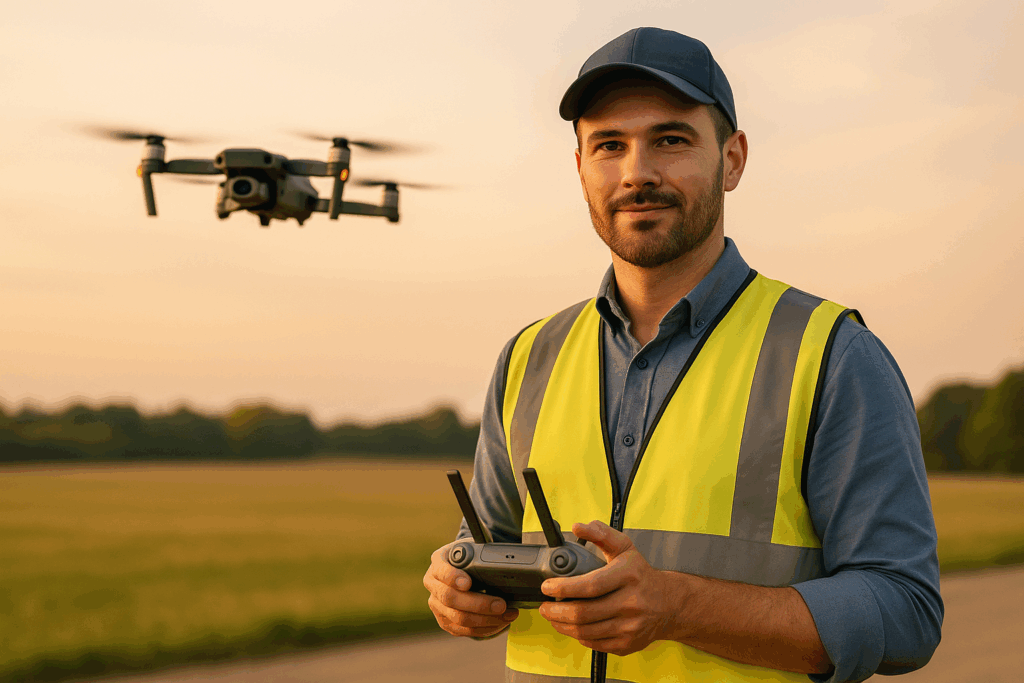FAA Part 107 certification is mandatory for anyone using drones commercially in the U.S. This includes activities like real estate photography, construction inspections, or promotional content. Without certification, you risk fines up to $27,500 or even criminal penalties.
Here’s what you need to know:
- Eligibility: Must be at least 16, a U.S. citizen or lawful resident, and proficient in English.
- Health: No medical certificate is required, but you must self-assess your fitness before flights.
- Steps to Certify: Pass the FAA’s aeronautical knowledge test ($175 fee), submit FAA Form 8710-13, and undergo a TSA background check.
- Renewal: Complete free online training every 24 months to stay certified.
Certification ensures safe, legal operations, builds credibility, and allows access to advanced permissions like night flights. Whether flying yourself or hiring a professional, always verify certification and insurance to avoid risks.
How to Get Your Part 107 in 2025
Who Can Apply for Part 107 Certification
The FAA has set clear guidelines for those interested in obtaining Part 107 certification, ensuring that commercial drone operations remain safe and accessible. Below is a breakdown of the key eligibility requirements to help you navigate the process.
Age, Citizenship, and Language Requirements
To qualify, you must be at least 16 years old. This age minimum reflects the FAA’s expectation that drone pilots demonstrate a certain level of maturity and responsibility. Additionally, applicants must be U.S. citizens, U.S. nationals, or lawful permanent residents.
Language skills are also essential. You need to be able to read, write, speak, and understand English. If you have a hearing or speaking impairment, the FAA won’t automatically disqualify you. However, if your impairment prevents you from meeting the language proficiency standard, specific operating limitations may be added to your certificate to ensure safety.
Physical and Mental Fitness Standards
Unlike traditional aircraft pilots, drone operators under Part 107 don’t need an airman medical certificate. That said, you must be in a physical and mental state that allows for safe drone operation. The FAA emphasizes this in its regulations:
“No person may manipulate the flight controls of a small unmanned aircraft system or act as a remote pilot in command, visual observer, or direct participant in the operation of the small unmanned aircraft if the operator knows or should know that he or she has a physical or mental condition that would interfere with the safe operation of the small unmanned aircraft system.”
- 14 CFR Section 107.17 (FAA)
Before every flight, you are required to self-assess your fitness. The FAA doesn’t provide a list of specific medical conditions that could disqualify you, as the impact of such conditions can vary. However, as a general rule, if you wouldn’t safely operate a car or heavy machinery due to factors like alcohol, drugs, medication, fatigue, illness, or emotional distress, you shouldn’t fly a drone. If in doubt, consulting a physician is always a good idea.
Options for Licensed Pilots
If you already hold a valid Part 61 pilot certificate – covering licenses such as student, recreational, private, commercial, or airline transport – you have a faster route to Part 107 certification. Instead of taking the full aeronautical knowledge test, you can complete an online training course focused on Part 107 regulations and procedures, followed by a shorter proficiency check. Keep in mind, your Part 61 certificate must be current; an expired or revoked license disqualifies you from this streamlined process.
For professionals in real estate, particularly those working with HomeJab, understanding these requirements ensures you’re collaborating with certified drone operators who meet all federal standards for commercial aerial photography. Familiarity with these rules also sets the stage for successfully obtaining and maintaining your own Part 107 certification if needed.
How to Get Your FAA Part 107 Certificate
If you meet the eligibility requirements, the next step is to follow the process to secure your Part 107 certification. This involves three main steps: passing the aeronautical knowledge test, completing FAA Form 8710-13, and receiving your certificate. Each step has its own requirements and timelines, so it’s important to understand them before getting started.
Taking the Aeronautical Knowledge Test
The aeronautical knowledge test is the first major step in earning your certification. You’ll need to schedule this exam at an FAA-approved testing center, which you can locate through the PSI Services website. The test fee is $175, payable directly to the testing center on the day of your exam.
The test consists of 60 multiple-choice questions covering topics such as airspace, weather, flight operations, and Part 107 regulations. You’ll have 2 hours to complete it, and a score of at least 70% is required to pass. Since the test covers a wide range of subjects, thorough preparation is key.
Plan to book your test at least 1–2 weeks in advance. When you go to the testing center, bring a government-issued photo ID and follow all security procedures. If you don’t pass the test on your first try, you can retake it after a 14-day waiting period, but you’ll need to pay the fee again.
Completing FAA Form 8710-13
Once you pass the knowledge test, there’s typically a 48-hour waiting period before you can submit your application. This allows the FAA to process your test results. After this, you can complete FAA Form 8710-13 through the IACRA system.
To fill out the form, you’ll need to provide personal details, proof of citizenship, and your test confirmation information. The IACRA system will automatically verify your test results, so make sure you have your confirmation details handy.
After submitting your application, the Transportation Security Administration (TSA) will conduct a background check. This process is automated and usually requires no additional input. If any issues arise, the TSA will contact you directly with further instructions.
Double-check all information on your application to avoid delays. Ensure your legal name matches across all documents, including your ID and test registration.
Getting Your Remote Pilot Certificate
Once your application is approved and the background check is complete, you’ll receive a temporary electronic Remote Pilot Certificate. This is typically issued within 10 business days and allows you to start commercial drone operations immediately. The temporary certificate can be stored digitally on your phone or printed for convenience.
The permanent Remote Pilot Certificate will be mailed by the FAA and usually arrives within 6 to 8 weeks. As noted by Drone Pilot Ground School:
“The FAA anticipates that, while it may take the FAA 6 to 8 weeks to issue a permanent Remote Pilot Certificate via snail mail, a temporary remote pilot certificate can be issued in about 10 business days.” – Drone Pilot Ground School
If you don’t receive your permanent certificate within eight weeks, contact the Airmen Certification Branch at (405) 954-3261 or toll-free at 1-866-878-2498 for assistance.
sbb-itb-82c5f45
Keeping Your Part 107 Certification Current
Getting your Part 107 certification is just the beginning. To legally operate under FAA rules, you need to stay compliant by completing recurrent training and keeping up with any regulatory changes. Here’s how you can stay on top of it all.
Required Training Every 24 Months
To keep your Part 107 certification active, you must complete recurrent training every 24 months. Thankfully, the renewal process is much easier than the initial certification. Instead of retaking an in-person knowledge exam, you can complete a free online course through the FAA Safety Team (FAASTeam) website.
Choose the appropriate course based on your certification type: ALC-677 for most Part 107 pilots or ALC-515 if you’re also certified under Part 61. These courses cover updates to regulations, such as rules for flying over people and conducting night operations without needing a waiver. To begin, create an account on FAASafety.gov, complete the relevant course, and save a digital copy of your course completion report as proof of renewal.
Monitoring FAA Rule Changes
Staying informed about FAA updates is just as important as completing your training. As a certified pilot, it’s your responsibility to keep up with evolving regulations. Here are some ways to stay in the loop:
- Subscribe to FAA email alerts through the Unmanned Aircraft Systems website to get notifications about updates.
- Check the FAA DroneZone’s “Hot Topics in U.A.S.” section regularly for new developments.
- Follow the Electronic Code of Federal Regulations (eCFR) and sign up for updates on 14 CFR Part 107.
The Federal Register is another valuable resource, where Notices of Proposed Rulemaking (NPRMs) provide early warnings about potential changes. For instance, the proposed Part 108 regulations for Beyond Visual Line of Sight (BVLOS) operations were published on August 7, 2025, with public comments accepted until October 6, 2025. Additionally, your recurrent training serves as a built-in update, ensuring you’re aware of the latest rules that impact commercial drone operations.
Drone Guidelines for Real Estate Professionals
If your Part 107 certification is up to date, you’re ready to combine federal protocols with local guidelines to incorporate aerial photography into your property marketing. Whether you’re flying drones yourself or working with certified professionals, knowing the rules will help you stay compliant while showcasing properties in a way that stands out.
Understanding Local and Federal Rules
Part 107 certification covers federal regulations, but local airspace restrictions often depend on where the property is located. Areas near airports, military bases, or national parks frequently fall under no-fly zones, which can extend beyond their immediate surroundings. Before each shoot, check tools like the B4UFLY app or LAANC to identify restrictions and secure any necessary authorizations.
Be aware that temporary flight restrictions (TFRs) can pop up with little notice due to emergencies, VIP travel, or major events. On top of that, local governments or homeowners’ associations might have their own rules, so it’s important to confirm any additional guidelines in your area before planning a flight.
Working with Certified Drone Photographers
Hiring professional drone photographers can take the stress out of navigating regulations while ensuring you get high-quality imagery. Services like HomeJab connect real estate agents with FAA Part 107-certified pilots who are well-versed in both federal and local compliance. Their packages, priced between $249 and $499, typically include 10–15 aerial photos and aerial video footage, with delivery often within 24 hours.
To verify a photographer’s Part 107 certification, check the FAA Airman Registry. Certified pilots are trained in airspace rules, weather considerations, and emergency protocols – details that unlicensed operators might miss. They also carry commercial liability insurance for added peace of mind.
Professional drone photographers bring advanced gear to the table, such as gimbal-stabilized cameras, neutral density filters, and GPS waypoint systems. This equipment ensures smooth footage and sharp images that elevate your property marketing. By combining their expertise with diligent record keeping, you can create a seamless and compliant aerial photography process.
Record Keeping and Documentation
Keep digital records of your Part 107 certification, drone registrations, and insurance policies to stay organized and compliant. For every shoot, document the property address, date, time, weather conditions, and authorization details.
Set up a system to link aerial photos to specific properties and store digital copies of all certifications, registrations, and insurance documents. Flight logs should include pilot details, aircraft information, and any deviations from planned operations – even if you’re not the one flying the drone.
Lastly, review your errors and omissions (E&O) insurance to ensure it covers drone-related marketing activities. Some policies include endorsements for aerial photography, while others may exclude it altogether. Understanding your coverage can help you manage risks and choose the right service providers for your needs.
Conclusion
For real estate professionals using drones in their work, obtaining FAA Part 107 certification isn’t just a legal box to check – it’s a must. This certification not only ensures you’re operating within the law but also strengthens your professional reputation.
Skipping certification comes with big risks. Even if you’re just helping a friend with a property listing, you’re still required to have Part 107 certification, as the activity doesn’t fall under recreational use.
But it’s not just about avoiding penalties. Certification opens the door to valuable business opportunities. Certified pilots are trained in airspace regulations, weather considerations, and safety protocols, which leads to smoother, more professional operations. It also gives you the kind of operational flexibility and credibility that clients notice and appreciate.
Whether you’re flying your own drone or hiring a professional, certification matters. If you’re working with drone photographers, always double-check that they have a valid Part 107 certification and carry at least $1 million in aviation liability insurance. Platforms like HomeJab can connect you with certified pilots who meet all federal and local requirements, giving you peace of mind and top-notch aerial images.
While the certification process – studying aeronautics, passing the exam, and keeping up with training – might seem like a challenge, it’s worth it. In a competitive real estate market, where aerial photography can set listings apart, Part 107 certification turns a legal obligation into a powerful tool for success.
FAQs
What happens if I fly a drone commercially without FAA Part 107 certification?
Operating a drone for business purposes without having the FAA Part 107 certification can result in severe penalties. The Federal Aviation Administration (FAA) can issue civil fines of up to $27,500, and criminal violations could lead to fines as high as $250,000 and even up to 3 years in prison.
Beyond the financial and legal consequences, you might also receive warnings, be required to complete safety training, and potentially harm your professional reputation. To steer clear of these issues, make sure you’re properly certified by the FAA before engaging in any commercial drone operations.
What is the FAA Part 107 certification process for Part 61 pilot certificate holders?
If you already have a Part 61 pilot certificate and want to operate under Part 107, you’ll still need to get a remote pilot certificate. The good news? You can skip the in-person knowledge test by taking the FAA’s free online recurrent training. This convenient option lets you meet the requirements for commercial drone operations without the hassle of extra testing.
How can I keep my FAA Part 107 certification active and up-to-date?
To keep your FAA Part 107 certification active, you must complete the required recurrent training every 24 months. This training is designed to keep you informed about the latest rules and operational guidelines for drone use. The good news? It’s entirely online and usually takes just 1–2 hours to finish.
If you let your certification expire without renewing it, you’ll lose the legal ability to fly drones for commercial purposes. To avoid any disruption, plan ahead and complete your renewal before the deadline.











